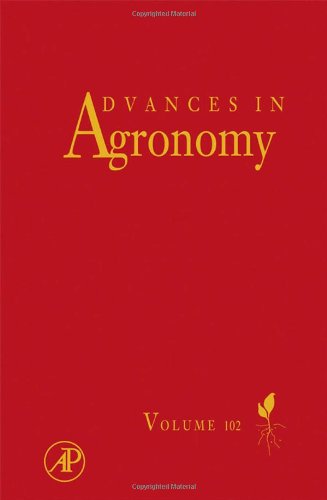

Most ebook files are in PDF format, so you can easily read them using various software such as Foxit Reader or directly on the Google Chrome browser.
Some ebook files are released by publishers in other formats such as .awz, .mobi, .epub, .fb2, etc. You may need to install specific software to read these formats on mobile/PC, such as Calibre.
Please read the tutorial at this link. https://ebooknice.com/page/post?id=faq
We offer FREE conversion to the popular formats you request; however, this may take some time. Therefore, right after payment, please email us, and we will try to provide the service as quickly as possible.
For some exceptional file formats or broken links (if any), please refrain from opening any disputes. Instead, email us first, and we will try to assist within a maximum of 6 hours.
EbookNice Team

Status:
Available5.0
34 reviews
ISBN 10: 0123748186
ISBN 13: 9780123748188
Author: Donald L Sparks
Advances in Agronomy continues to be recognized as a leading reference and a first-rate source of the latest research in agronomy. Major reviews deal with the current topics of interest to agronomists, as well as crop and soil scientists. As always, the subjects covered are varied and exemplary of the myriad of subject matter dealt with by this long-running serial. Editor Donald Sparks, former president of the Soil Science Society of America and current president of the International Union of Soil Science, is the S. Hallock du Pont Chair of Plant and Soil Sciences at The University of Delaware.
* Maintains the highest impact factor among serial publications in agriculture
* Presents timely reviews on important agronomy issues
* Enjoys a long-standing reputation for excellence in the field
ARSENIC CONTAMINATION AND ITS RISK MANAGEMENT IN COMPLEX ENVIRONMENTAL SETTINGS
I. INTRODUCTION
II. ORIGIN AND SOURCES OF ARSENIC CONTAMINATION
III. DISTRIBUTION AND SPECIATION OF ARSENIC IN THE ENVIRONMENT
IV. BIOGEOCHEMISTRY OF ARSENIC IN THE ENVIRONMENT
V. BIOAVAILABILITY AND TOXICITY OF ARSENIC TO BIOTA
VI. RISK MANAGEMENT OF ARSENIC IN CONTAMINATED ENVIRONMENTS
VII. SUMMARY AND FUTURE RESEARCH NEEDS
ACKNOWLEDGMENTS
REFERENCES
THE CONTRIBUTION OF BREEDING TO YIELD ADVANCES IN MAIZE (ZEA MAYS L.)
I. INTRODUCTION
II. GENETIC GAINS IN GRAIN YIELD OF HYBRIDS
III. GENETIC GAINS FROM POPULATION IMPROVEMENT
IV. ANALYSIS AND CONCLUSIONS
REFERENCES
METABOLIC ENGINEERING OF ISOFLAVONE BIOSYNTHESIS
I. THE HEALTH BENEFITS OF ISOFLAVONES IN SOYBEANS
II. BIOLOGICAL FUNCTIONS OF ISOFLAVONOIDS IN PLANTS
III. TARGETS OF ISOFLAVONE ENGINEERING
IV. THE PATHWAY LEADING TO ISOFLAVONE BIOSYNTHESIS
V. THE ENTRY POINT ENZYME: ISOFLAVONE SYNTHASE
VI. OTHER KEY ENZYMES IN ISOFLAVONE BIOSYNTHESIS
VII. TRANSCRIPTIONAL AND POSTTRANSCRIPTIONAL REGULATION OF RELATED PATHWAYS
VIII. METABOLIC ENGINEERING OF ISOFLAVONE ACCUMULATION IN LEGUMES
IX. METABOLIC ENGINEERING OF ISOFLAVONE ACCUMULATION IN NONLEGUMES
X. THE BOTTLENECK OF ISOFLAVONE PATHWAY ENGINEERING: “METABOLIC CHANNELING?”
XI. CONCLUSIONS
REFERENCES
BIOLOGICAL CONTROL OF WEEDS WITH ANTAGONISTIC PLANT PATHOGENS
I. INTRODUCTION
II. BIOLOGICAL CONTROL OF WEEDS
III. HISTORY OF BIOLOGICAL CONTROL METHODS
IV. STRATEGIES OF WEED BIOLOGICAL CONTROL
V. FACTORS AFFECTING THE EFFICACY OF PATHOGENS USED IN BIOLOGICAL WEED CONTROL
VI. FORMULATION OF BIOLOGICAL CONTROL AGENTS
VII. LIMITATIONS AND JUSTIFICATIONS OF BIOLOGICAL WEED CONTROL
VIII. OVERALL CONCLUSION
REFERENCES
NUTRIENT STOCKS, NUTRIENT CYCLING, AND SOIL CHANGES IN COCOA ECOSYSTEMS: A REVIEW
I. INTRODUCTION
II. CLIMATIC AND SOIL CONDITIONS OF STUDY AREAS
III. NUTRIENT STOCKS
IV. NUTRIENT CYCLING
V. NUTRIENT BALANCES
VI. SOIL CHANGES UNDER COCOA
VII. DISCUSSION
VIII. CONCLUDING REMARKS
ACKNOWLEDGMENTS
REFERENCES
RICE–WHEAT CROPPING SYSTEMS
I. INTRODUCTION
II. CLIMATE AND SOILS
III. AGRONOMIC MANAGEMENT
IV. GENETIC MANIPULATION
V. SUSTAINABILITY OF RICE– WHEAT CROPPING SYSTEMS
VI. SOCIOECONOMIC AND POLICY FACTORS
VII. FUTURE RESEARCH NEEDS
ACKNOWLEDGMENTS
References
INTERACTIONS OF NITROGEN WITH OTHER NUTRIENTS AND WATER: EFFECT ON CROP YIELD AND QUALITY, NUTRIENT
I. INTRODUCTION
II. NITROGEN x PHOSPHORUS INTERACTION
III. NITROGEN x POTASSIUM INTERACTION
IV. NITROGEN x SULFUR INTERACTION
V. NITROGEN x CALCIUM AND NITROGEN x MAGNICIUM INTERACTIONS
VI. NITROGEN x MICRONUTRIENTS INTERACTIONS
VII. NITROGEN x WATER INTERACTION
VIII. EFFECTS ON CARBON STORAGE AND SEQUESTRATION IN SOIL
IX. NITROGEN LOSSES AND TRENDS OF FERTILIZER CONSUMPTION
X. CONCLUSIONS AND FUTURE RESEARCH NEEDS
ACKNOWLEDGMENTS
advances in agronomy book
advances in agricultural science
introduction to agronomy food crops and environment 2nd edition pdf
a textbook on recent advances in agronomy
u of i agronomy handbook
r agronomy
Tags: Donald L Sparks, Advances, Agronomy